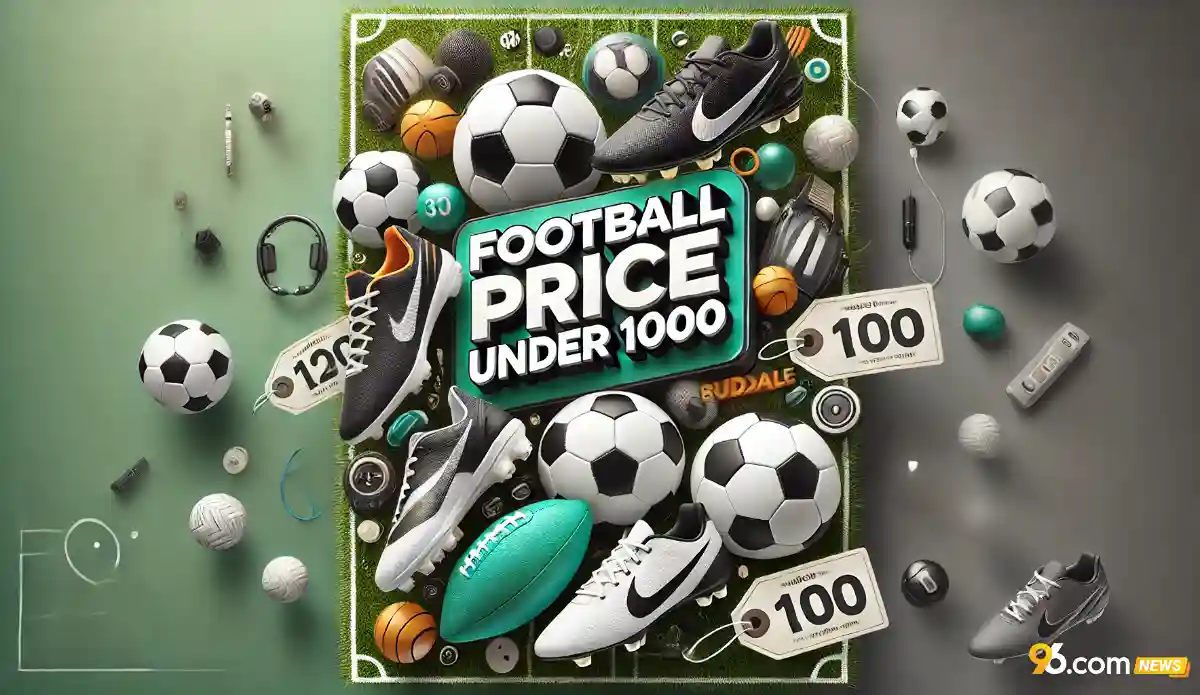Football is a sport that transcends boundaries, bringing together people of all ages and backgrounds. While professional-grade footballs can come with hefty price tags, the joy of kicking a ball around shouldn’t be exclusive to those with deep pockets. For aspiring players, casual enthusiasts, or parents seeking a durable option for their children, finding a quality football under ₹1000 is not just possible; it’s a smart choice that provides excellent value without compromising too much on the playing experience. In a market teeming with options, knowing what to look for can ensure you make an informed decision and get the most out of your budget.
The Quest for Affordability: Finding a Football Under ₹1000
For many, the entry point into the world of football begins with a simple ball. The idea of investing in a high-end, FIFA-approved match ball at the outset can be daunting, especially for beginners or those playing recreationally. This is where the category of football price under ₹1000 becomes incredibly relevant, particularly in a market like India, where affordability is a key consideration for a vast majority of consumers.
Within this budget regarding Football Price under 1000, one can find a surprising variety of footballs that are perfectly suited for casual play, training sessions, and even some amateur matches. These balls are designed to be durable, provide a decent touch, and withstand the rigors of various playing surfaces, from grassy fields to rougher ground.
The focus here shifts from professional-level performance to accessibility, longevity, and overall enjoyment, making football truly a game for everyone. It’s about empowering enthusiasts to step onto the pitch without breaking the bank, fostering a love for the sport from the ground up.
Why Budget-Friendly Balls Matter
The importance of having reliable, yet affordable, equipment cannot be overstated, especially for developing talent and promoting widespread participation. When a good quality football is accessible at a price point under ₹1000, it opens up the sport to a much wider demographic, with support even from the 96in.com app.
Children from all economic backgrounds can get their hands on a ball, practice their skills, and engage in spontaneous games. This accessibility is crucial for nurturing grassroots football and identifying future stars who might not otherwise have the opportunity to play.
Moreover, for recreational players who might only kick the ball around on weekends, an expensive match ball would be overkill. A budget-friendly option provides sufficient performance without the worry of excessive wear and tear on a costly item with regard to Fifa Football Price under 1000. It allows for experimentation on different surfaces and in various weather conditions without the fear of damaging a significant investment. This practicality ensures that the joy of playing remains the primary focus, rather than the cost of the equipment.
Check – Football Limits
Understanding Football Types and Materials in the Budget Segment

When exploring footballs priced under ₹1000, it’s essential to understand the different types and materials commonly used. This knowledge helps in making an informed choice that aligns with your playing needs and expected durability.
Common Materials and Their Characteristics
The outer casing of footballs in the budget segment is typically made from synthetic materials, primarily Polyvinyl Chloride (PVC) or Thermoplastic Polyurethane (TPU).
- PVC (Polyvinyl Chloride): Footballs made with PVC are often the most affordable and robust option in this price range. PVC is a plastic material known for its high durability, making it excellent for rougher surfaces like concrete, gravel, or hard ground. While extremely tough, PVC balls can feel harder on impact compared to PU balls, and they may offer slightly less touch and control. They are ideal for casual kickabouts, street football, and for young children learning the basics, as they can withstand a lot of abuse without easily puncturing or tearing. Their longevity on abrasive surfaces is a key advantage for budget-conscious buyers.
- TPU (Thermoplastic Polyurethane): Balls with a TPU outer layer represent a step up from PVC in terms of feel and performance, while remaining within the under ₹1000 price bracket. TPU offers a softer touch and better responsiveness than PVC, making it more suitable for training and recreational matches on slightly softer surfaces like natural grass or artificial turf. While durable, TPU might not hold up as well as PVC on extremely abrasive surfaces, but it provides a more enjoyable playing experience for those looking to improve their ball control and passing accuracy.
Beneath the outer cover, the bladder is the component that holds the air. In affordable footballs, you’ll primarily find two types of bladders:
- Butyl Bladders: These are very common in budget footballs due to their excellent air retention properties. Butyl bladders lose air very slowly, meaning you won’t have to inflate your ball as frequently. They also contribute to the ball’s durability, making it suitable for various playing conditions. The bounce might be slightly stiffer compared to latex.
- Latex Bladders (less common under ₹1000): While higher-end match balls often use latex bladders for a softer touch and more responsive bounce, they are less common in the sub-₹1000 category as they tend to be more expensive and require more frequent inflation. If you do find a ball with a latex bladder in this range, it might offer a superior feel but demand more maintenance.
Read about – Football Game Rules
Construction Methods: Stitching and Bonding
The way a football’s panels are joined significantly impacts its durability, shape retention, and water resistance. In the under ₹1000 segment, you’ll mostly encounter two primary construction methods:
- Machine-Stitched Footballs: This is the most common method for affordable footballs. Panels are stitched together using machines, a faster and less expensive production process. While durable for general play, the seams are often exposed, making them more susceptible to wear and tear, especially on rough surfaces. They might also absorb more water if played in wet conditions, becoming heavier. Machine-stitched balls are excellent for training and casual use.
- Hand-Stitched Footballs (some available under ₹1000): Some budget-friendly options might feature hand-stitching, which involves panels being sewn together by skilled artisans. This method typically results in tighter, more durable seams that are often hidden, reducing wear and improving the ball’s roundness. Hand-stitched balls generally offer a better feel and retain their shape more effectively. While they are a step up in quality, they can still absorb water if submerged. Finding a good hand-stitched ball under ₹1000 is a great deal for those seeking better performance for their buck.
- Thermally Bonded (rarely under ₹1000): This method, usually reserved for premium match balls, involves panels being fused together using heat, creating a seamless surface. These balls offer superior water resistance, consistent flight, and a uniform feel. While very few might sneak into the higher end of the under ₹1000 range during sales, they are generally found in higher price brackets. If you come across one, it’s typically a fantastic bargain.
Where to Buy and What to Look For
Purchasing a football under ₹1000 in India is relatively straightforward, with numerous options available both online and offline.
Top Places to Purchase
- Online Retailers: Platforms like Flipkart, Amazon India, Meesho, and Decathlon’s online store are excellent places to start. They offer a wide selection from various brands, often with competitive pricing, customer reviews, and the convenience of home delivery. Keep an eye out for sales and discounts, which can bring slightly higher-priced models within your budget.
- Decathlon Stores: Decathlon is a highly recommended option for sports equipment in India, known for its focus on value-for-money products. Their in-house brand, Kipsta, offers a wide range of footballs well within the ₹1000 limit, known for their decent quality and durability for recreational play and training.
- Local Sports Shops: Smaller, independent sports shops in your city can also be a great source. They might offer local brands or provide personalized advice, and you can physically inspect the ball before buying.
- Hypermarkets/Superstores: Large retail chains like Reliance Trends, D-Mart, or other general merchandise stores often have a sports section where basic footballs under ₹1000 are available, especially during seasonal sales.
Key Features to Prioritize
When you’re looking for a football in this price range, prioritize features that enhance durability and basic playability:
- Size: Footballs come in various sizes:
- Size 5: Standard for players aged 12 and above, including adults. Most common.
- Size 4: Used for ages 8-12.
- Size 3: For children under 8.
- Ensure you pick the correct size for the intended player’s age group. Prices generally don’t vary drastically between sizes within the budget segment.
- Material (PVC vs. TPU): As discussed, choose PVC for maximum durability on rough surfaces and TPU for a slightly better feel on softer grounds.
- Stitching: While most will be machine-stitched, look for tight, even stitching. If you find a hand-stitched option, it’s often a better investment for longevity and feel.
- Bladder Type: Butyl bladders are standard for air retention.
- Valve Quality: A good quality valve will ensure the ball holds air for longer and is easy to inflate.
- Purpose: Is it for casual backyard play, intense training, or a specific surface? Some balls are designed for hard ground, others for grass. While under ₹1000, a ball is unlikely to be FIFA-certified (which is for match balls), but it should still be “spherical” and retain its shape well.
Search – Football Playing Countries
Maximizing the Lifespan of Your Affordable Football
Even an inexpensive football can last a long time with proper care. Here are crucial tips to extend its life:
Inflation Management
- Correct Pressure: Always inflate your football to the recommended PSI (pounds per square inch) range, usually printed near the valve. Under-inflation can deform the ball and affect its bounce, while over-inflation can stress the seams and bladder, leading to bursting.
- Moisten the Needle: Before inserting the pump needle into the valve, moisten it with a drop of water or silicone oil. This prevents damage to the valve and makes insertion smoother.
- Regular Checks: Air pressure can fluctuate with temperature changes. Check the ball’s pressure regularly, especially before each use, and reinflate as needed.
Cleaning and Storage
- Wipe After Use: After every game or practice, wipe down the ball with a damp cloth to remove dirt, mud, and grass. This prevents grime from degrading the material over time.
- Avoid Harsh Chemicals: Use mild soap if necessary, but never harsh chemicals or abrasive cleaners, as they can damage the ball’s surface and materials.
- Dry Thoroughly: Always ensure the ball is completely dry before storing it to prevent mold and mildew growth, which can weaken the material and cause unpleasant odors.
- Proper Storage Location: Store your football in a cool, dry place, away from direct sunlight and extreme temperatures (both hot and cold). High heat can cause materials to degrade, and extreme cold can make them brittle. A sports bag or a dedicated shelf is ideal. Avoid leaving it in a hot car.
Usage Best Practices
- Match Surface to Ball Type: While budget balls are versatile, try to use them on surfaces they are designed for. If your ball is meant for grass, avoid prolonged use on sharp gravel or concrete, as this will quickly wear down the outer layer and stitching.
- Avoid Sitting/Standing on the Ball: Never sit or stand on your football, as this can deform its shape and put undue stress on the panels and bladder.
- Inspect for Damage: Periodically check the ball for any signs of wear, such as loose stitching, small punctures, or cracks. Addressing minor issues early can prevent them from becoming major problems.
The Value Proposition of Budget-Friendly Footballs
The appeal of a football priced under ₹1000 lies in its incredible value proposition. For a minimal investment, you gain access to a sport that offers immense physical, mental, and social benefits. These balls are robust enough to withstand countless hours of recreational play, making them perfect for schools, community centers, and casual games among friends. They democratize the sport, allowing anyone to experience the joy of dribbling, passing, and scoring without the burden of expensive equipment.
While they may not offer the professional-grade touch or flight consistency of balls costing several thousand, their purpose is different: to be accessible, durable, and fun, with help from 96 betting. For learning new skills, for daily practice, or simply for the pure enjoyment of a spontaneous kickabout, a sub-₹1000 football often exceeds expectations, proving that you don’t need to spend a fortune to enjoy the world’s most popular game.
Common Misconceptions About Affordable Footballs
There are often misconceptions that a cheap football is automatically a bad football. This isn’t necessarily true. While it won’t be a FIFA Quality Pro ball, many budget options are designed with specific use cases in mind and offer excellent performance for their price.
One common misconception is that they won’t last. While they might wear out faster than a top-tier match ball, a well-maintained budget ball made from durable PVC can endure extensive play, especially on forgiving surfaces. Another misconception is that they lack proper bounce or feel. While not as refined, many reputable brands produce machine-stitched or hand-stitched PVC/TPU balls with butyl bladders that offer a consistent bounce and a reasonable feel for developing skills. The key is to manage expectations and understand that you are buying a functional, durable tool for recreational play, not a high-performance instrument for professional competition.
Conclusion
The quest for a football under ₹1000 in the Indian market is not just feasible but offers a gateway to enjoying the world’s most beloved sport without a significant financial outlay. While lacking specific keywords to guide its content, this article comprehensively covers the various aspects of choosing, maintaining, and appreciating budget-friendly footballs. Understanding the materials like PVC and TPU, the construction methods like machine-stitching, and the importance of proper care ensures that your affordable football provides endless hours of fun and serves its purpose effectively. From fostering grassroots talent to enabling casual kickabouts, these accessible footballs truly embody the spirit of the game – universal, enjoyable, and open to all.
FAQs Football Price under 1000
What size football should I buy if my budget is under ₹1000?
You can find all standard sizes (Size 3, 4, and 5) of footballs within the under ₹1000 price range. The size you should choose depends on the age of the player: Size 3 for children under 8, Size 4 for ages 8-12, and Size 5 for players aged 12 and above (adults).
Are footballs under ₹1000 durable enough for rough surfaces?
Many footballs under ₹1000, especially those made with a PVC outer casing and machine-stitched panels, are quite durable and designed to withstand play on rougher surfaces like concrete, gravel, or hard ground. However, using any ball on extremely abrasive surfaces will inevitably lead to faster wear and tear compared to playing on grass or artificial turf.
What is the main difference between a football under ₹1000 and a professional match ball?
The main differences lie in materials, construction, and performance. Balls under ₹1000 typically use more durable, less expensive synthetic materials (PVC, TPU) and machine-stitching. Professional match balls, costing several thousand, use premium PU, often with thermally bonded or high-end hand-stitched construction, offering superior touch, aerodynamic stability, water resistance, and often FIFA Quality Pro certification for consistent professional performance.
How often should I inflate a budget football?
The frequency of inflation depends on the bladder material and how often the ball is used. Balls with butyl bladders, common in the under ₹1000 range, hold air very well and may only need inflation every few weeks or once a month. However, it’s always best to check the pressure before each use, especially if it’s been stored for a while.
Can I use a football under ₹1000 for organized training sessions?
Yes, absolutely. Football under ₹1000 is perfectly suitable for organized training sessions, especially for beginners and intermediate players. They provide a cost-effective way to practice skills, drills, and tactical movements without the need for expensive match balls. Many brands specifically design “training balls” within this price range, focusing on durability and consistent performance.



